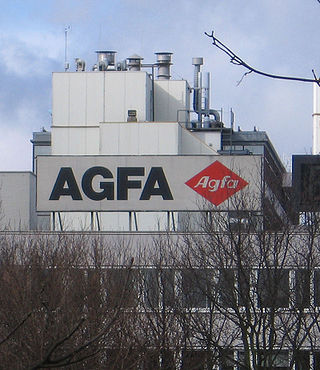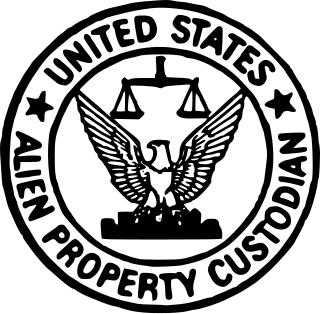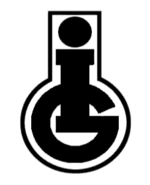
I. G. Farbenindustrie AG, commonly known as IG Farben, was a German chemical and pharmaceutical conglomerate. It was formed in 1925 by merging six chemical companies later known as BASF Aktiengesellschaft, Bayer AG, Hoechst Aktiengesellschaft, Agfa-Gevaert Group, and Cassella AG. The conglomerate was seized by the Allies after World War II and split into its constituent companies; parts in East Germany were nationalized.

Agfa-Gevaert N.V. (Agfa) is a Belgian-German multinational corporation that develops, manufactures, and distributes analogue and digital imaging products, software, and systems.

BASF SE, an initialism of its original name Badische Anilin- und Sodafabrik, is a German multinational company and the largest chemical producer in the world. Its headquarters are located in Ludwigshafen, Germany.

Union Bank of Switzerland (UBS) was a Swiss investment bank and financial services company located in Switzerland. The bank, which at the time was the second largest bank in Switzerland, merged with Swiss Bank Corporation in 1998 to become UBS. This merger formed what was then the largest bank in Europe and the second largest bank in the world.

Hoechst AG was a German chemicals, later life sciences, company that became Aventis Deutschland after its merger with France's Rhône-Poulenc S.A. in 1999. With the new company's 2004 merger with Sanofi-Synthélabo, it became a subsidiary of the resulting Sanofi-Aventis pharmaceuticals group.

Banking in Switzerland dates to the early 18th century through Switzerland's merchant trade and over the centuries has grown into a complex and regulated international industry. Banking is seen as emblematic of Switzerland and the country has been one of the largest offshore financial centers and tax havens in the world since the mid-20th century, with a long history of banking secrecy and client confidentiality reaching back to the early 1700s. Starting as a way to protect wealthy European banking interests, Swiss banking secrecy was codified in 1934 with the passage of a landmark federal law, the Federal Act on Banks and Savings Banks. These laws were used to protect assets of persons being persecuted by Nazi authorities but have also been used by people and institutions seeking to illegally evade taxes, hide assets, or to commit other financial crime.
Swiss Bank Corporation was a Swiss investment bank and financial services company located in Switzerland. Prior to its merger, the bank was the third largest in Switzerland, with over CHF 300 billion of assets and CHF 11.7 billion of equity.

Credit Suisse Group AG is a global investment bank and financial services firm founded and based in Switzerland as a standalone firm but now a subsidiary of UBS. According to UBS, eventually Credit Suisse will be fully integrated into UBS but while the integration is not complete both banks are operating separately. Headquartered in Zürich, as a standalone firm it maintained offices in all major financial centers around the world and provided services in investment banking, private banking, asset management, and shared services. It was known for strict bank–client confidentiality and banking secrecy. The Financial Stability Board considered it to be a global systemically important bank. Credit Suisse was also a primary dealer and Forex counterparty of the Federal Reserve in the United States.
The American IG Chemical Corporation, or American IG for short, was an American holding company incorporated under the Delaware General Corporation Law in April 1929 and headquartered in New York City. It had stakes in General Aniline Works (GAW), Agfa-Ansco Corporation, and Winthrop Chemical Company, among others, and was engaged in manufacture and sale of pharmaceuticals, photographic products, light weight metals, synthetic gasoline, synthetic rubber, dyes, fertilizers, and insecticides. The Moody's industrial manual listed an affiliation between IG Farben and American IG at the time of founding. First, Hermann Schmitz, who was the second after Carl Bosch in IG Farben's hierarchy, and then his brother, Dietrich A. Schmitz, served as American IG's presidents. It was re-incorporated as General Aniline & Film (GAF) Corp. in 1939 after a merger with General Aniline Works.

GIC Private Limited is a Singaporean sovereign wealth fund that manages the country's foreign reserves. Established by the Government of Singapore in 1981 as the Government of Singapore Investment Corporation, from which the acronym "GIC" is derived, its mission is to preserve and enhance the international purchasing power of the reserves, with the aim to achieve good long-term returns above global inflation over the investment time horizon of 20 years.
Julius Bär Group AG, known alternatively as Julius Baer Group Ltd., is a private banking corporation founded and based in Switzerland. Headquartered in Zürich, it is among the older Swiss banking institutions. In terms of assets under management, Julius Baer is number two among Swiss banks after UBS and the biggest pure-play private bank. The bank's reputation has been marred by various controversies and legal challenges. These include a legal dispute with WikiLeaks in 2008, allegations of aiding U.S. citizens in tax evasion in 2011, and a censure by the Swiss Financial Market Supervisory Authority (FINMA) in 2020 for deficiencies in combating money laundering. The bank has also been implicated in money laundering scandals involving corrupt Venezuelan officials and has faced investigations for its role in the FIFA corruption case. These controversies have cast a shadow on its legacy and raised questions about its compliance and ethical practices.

The Office of Alien Property Custodian was an office within the government of the United States during World War I and again during World War II, serving as a custodian to property that belonged to US enemies. The office was created in 1917 by Executive Order 2729-A under the Trading with the Enemy Act of 1917 (TWEA) in order to "assume control and dispose of enemy-owned property in the United States and its possessions."

Ansco was the brand name of a photographic company based in Binghamton, New York, which produced photographic films, papers and cameras from the mid-19th century until the 1980s.
Dillon, Read & Co. was an investment bank based in New York City. In 1991, it was acquired by Barings Bank and, in 1997, it was acquired by Swiss Bank Corporation, which was in turn acquired by UBS in 1998.

UBS Group AG is a multinational investment bank and financial services company founded and based in Switzerland. Headquartered simultaneously in Zürich and Basel, it maintains a presence in all major financial centres as the largest Swiss banking institution and the largest private bank in the world. UBS investment bankers and private bankers are known for their strict bank–client confidentiality and culture of banking secrecy. Because of the bank's large positions in the Americas, EMEA and Asia Pacific markets, the Financial Stability Board considers it a global systemically important bank.
Gary P. Brinson is a former investor and money manager. He is the founder of Brinson Partners a Chicago-based asset management firm acquired in 1994 by Swiss Bank Corporation, the predecessor of UBS, and Adams Street Partners. Prior to retiring in 2000, Brinson would run the asset management division of Swiss Bank Corporation and later UBS Global Asset Management.
John P. Costas is an American businessman, banker, and trader. He is the former chairman and CEO of UBS Investment Bank, where he oversaw the growth of the Swiss bank's investment banking franchise globally from 2000 to 2005. From 2005 through 2007, Costas was the chairman and CEO of Dillon Read Capital Management, a UBS proprietary trading unit and alternatives management company.

Vontobel is international investment management firm with Swiss roots, providing investment, advisory and solution capabilities to private and institutional clients. Headquartered in Zurich, Switzerland, the firm is present across 28 locations world-wide.
Baumann & Cie, Banquiers, headquartered in Basel, is a Swiss private bank specializing in wealth management and investment advisory.












